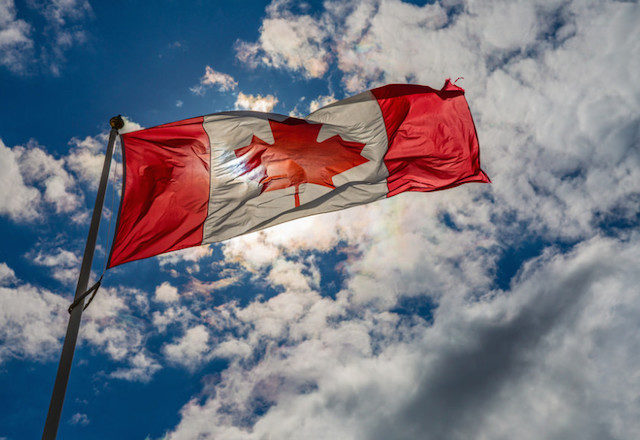Canada is often overlooked when considering the Allied contribution to victory in World War II, with the United States, Great Britain, the Soviet Union, and China receiving the most attention. Canada’s contribution was enormous, and a list of ten major contributions barely scratches the surface. Before World War II, Canada, as a territory of the British Empire, relied on the Royal Navy to protect its ports and shipping. When the war began, the Royal Canadian Navy consisted of just seven warships. When the war ended, Canada boasted the third largest navy in the world.
Canadian troops fought with distinction in several theaters of war, while their naval commanders coordinated massive convoys that carried the tools of war from North America to Britain and Europe. Its factories produced weapons, clothing, and equipment. Its fields produced food, and its coal, iron, and oil reserves fueled the Allied effort to destroy Hitler and the Japanese imperialists. At the same time, Canada provided refuge to exiles from Europe and safely housed prisoners of war captured by its own troops and those of the British Empire. These are just a few of Canada’s contributions to the Allied victory in World War II.
10. Battle of the Atlantic

Of all the operations in the European Theatre of Operations during World War II, the Battle across the Atlantic was most important to the Allied success. The ships carried weapons and vehicles, food and clothing, medicine and supplies from the industrial bases of North and South America to Britain and the Soviet Union. Roughly speaking, whoever controlled the Atlantic shipping lanes would win the war. Germany recognized this fact and sought to close the Atlantic to shipping through its U-boat offensive, through surface raiders early in the war, and by bombing or otherwise destroying its enemies' port facilities. They sank more than 13.5 million tons of shipping, not counting the 175 warships that fought to stop them during the war.
To defeat the Germans, the Allies created a convoy system to bring supplies from the West into the war zone. In addition to responsibility for the critical port of Halifax and the Gulf of St. Lawrence, large swaths of ocean traversed by convoys from New York, Boston, and other ports were defended primarily by Canadian forces. Canada built dozens of small, fast, multi-role ships known as corvettes. Smaller than destroyers and manned primarily by reservists, these ships patrolled the seas between the North American coast and Iceland, one of the U-boats’ favorite hunting grounds in the early years of the war. The Royal Canadian Navy was not limited to operations in the North Atlantic; Canadian escorts escorted coastal convoys to ports in South America fighting the Axis.
9. Fortification of the Atlantic Coast and Newfoundland

Newfoundland was a self-governing British dominion, legally separate from Canada until 1934, and remained independent in a practical sense when war broke out in 1939. In fact, ownership of the territory of Labrador was the subject of a dispute between Newfoundland and Canada in 1939. year . The war changed the relationship. Both the United Kingdom and the United States recognized the strategic importance of Newfoundland at the start of the war, and the Treaty of Destroyer bases 1940 allowed the United States create military bases to guard the American coast, manned by American troops, and service American aircraft and ships. When the war began, Canada established its own military presence.
Americans and Canadians worked together to make Newfoundland and Labrador a forward area for the defense of the North American coast and, importantly, the shipping lanes between it and the Iceland-Greenland Gap. The latter area, which included the Denmark Strait, was critical to shipping between North America and Europe. Canadians built defenses, including air bases at Gander, Torbay, and Goose Bay, which provided protection against the threat of German submarines. About 6,000 Canadian troops occupied Newfoundland during the war, joining about 10,000 American allies.
Together, the Americans and Canadians ensured that Newfoundland and Labrador remained in Allied hands, protecting the port of Halifax and the mouth of the St. Lawrence River from German attack. A German occupation of Newfoundland was a very real threat in 1940, since the British were powerless to stop it after the debacle at Dunkirk and the United States was not yet involved in the war. German bases in Newfoundland during the war were not a far-fetched idea. At the beginning of the war they installed on the island weather observation station , which neither Canadians nor Americans could find for decades.
8. Dieppe Raid: A combined attack on Nazi-controlled France in 1942.

Dieppe Raid 1942 ( Operation Jubilee ") was originally a British show. It was an attack on the French mainland, the aim of which was always to retreat after destroying some German installations and infrastructure, rather than to create a second front in Europe. As such, it was essentially a commando operation, but rather than tasking it to commando troops, the British assigned responsibility for the raid to their Canadian allies. It was essentially a hit-and-run operation; the Allies would land with armoured support, capture the port of Dieppe, destroy it and its support facilities, and retreat back to the sea from whence they had come.
During the rehearsals in Britain, failure followed failure. Lord Mountbatten, inexperienced for such an operation, commanded it, and after reviewing the training operations and the shortcomings they revealed, the British General Montgomery cancelled the plan that had previously been called Operation Rutter. But Churchill liked it because it showed Stalin's support for the Second Front in Europe, and it went ahead. The operation was a disaster. The British lacked air superiority, so they refused to risk large ships to bombard the shore before the invasion (the Japanese, with air superiority, had recently sunk two British capital ships off the Malay Peninsula). British reconnaissance of the landing areas was inaccurate and incomplete. The force they deployed was insufficient to overwhelm the defenses they encountered.
Just over 5,000 Canadian troops came ashore at Dieppe, meeting strong German resistance from ground troops, artillery, and the Luftwaffe. Supported by about 1,000 British commandos, they pushed inland, where their units were torn apart by German resistance. The Canadians suffered about 3,300 killed and wounded, and nearly 2,000 more were captured by the Germans (casualty figures vary depending on the source), a devastating toll. Churchill called the raid a success, citing the lessons learned as key to the subsequent victory in Normandy. In Canadait was and still is is considered a disastrous example of hubris that cost dearly, although the courage and capabilities of the Canadian troops were acknowledged beyond doubt by both Allied and German leaders.
7. Feeding and arming allies

During World War II, Canada, like its southern neighbor and, further afield, its South American allies, faced the challenge of feeding the Allies opposing Germany and Japan. At the same time, Canada needed men to staff its army, navy, and air force, and to operate the machines that built the war machines. Canadians, like Americans, replaced men in industrial jobs with women, allowing more Canadians to wear their country’s uniform. With a much smaller population than the United States, Canada was forced to take more drastic action. One step was age reduction , upon reaching which one could obtain a driver's license. Junior drivers helped the shipping pipeline and freed up more adults to perform other duties.
Canadian shipyards produced cargo hulls and warships for their rapidly expanding navy. Aircraft were built under license from American and British manufacturers. Canadian factories tanks and trucks, jeeps and ambulances, guns and blankets, uniforms and boots were produced. Timber was cut, trimmed and hauled to factories. Fields produced grain and vegetables, orchards yielded fruit, and the meatpacking industry flourished. Canada, which before the war had been one of the world's leading wheat producers, was forced to curtail this valuable crop and concentrate instead on growing the coarser grains needed to feed the cattle and pigs demanded by the fighting Allies. Canada's farms rose to the challenge: by 1944 they were producing more than twice the pre-war number of pigs for slaughter.
Production of beef, eggs, dairy products, vegetables, and fruits increased accordingly during the war years. Farm equipment and machinery were subject to rationing, and labor shortages on Canadian farms threatened production until interned Germans and Japanese were recruited to work in the fields and processing plants. They were later supplemented by German and Italian prisoners of war sent to Canada for the duration of the conflict. Agricultural production in Canada was one of the most important contributions to victory in World War II.
6. Canadians took part in the invasion of Sicily and Italy in 1943.

The Anglo-American allies began the ground war against Nazi Germany with landings in North Africa in late 1942. In 1943 they were ready to move against the European continent. There was debate about how to do this. Churchill wanted an invasion of the Caucasus. The Americans preferred either southern France or Italy. When it became obvious that Italy would win the Allied strategy, starting with capture of Sicily , Canadian Prime Minister William Mackenzie King demanded that Canadian troops be included in the active forces involved.
Although the Sicilian operation was under the overall command of American General Dwight Eisenhower, the British forces came under the command of Bernard Law Montgomery. Montgomery considered himself the most experienced of the Allied commanders and initially opposed the inclusion of Canadian troops before relenting and placing them under his command as part of the XXX Corps of the 1st Canadian infantry division.
Canada's operations in Sicily established them as a frontline force, equal to their contemporaries in capability and morale. Following the German evacuation of Sicily, the Allies invaded Italy in September 1943; Italy surrendered the same day. Canadian troops fought the Germans and the Italians who were forced to continue fighting by their German "allies" in some of the most heavy fighting on the Italian boot. The Canadians fought in rugged mountainous terrain, in winter mud that paralyzed tanks and equipment, in villages and towns in fierce urban house-to-house fighting. Despite heavy losses and strong German resistance, they prevailed everywhere.
Canadian troops were withdrawn from Italy in early 1945 and were needed elsewhere on the Western Front. During participation in the Italian campaign The Canadians lost over 5,500 killed and over 20,000 wounded, a casualty rate exceeding 27%, a testament to the stiff resistance they faced and their own tenacity as the vanguard troops of the Allied forces in Europe.
5. Canadian soldiers were killed by German invaders during the invasion of Normandy in 1944.

The invasion of Normandy, known to history as D-Day, although it was one of many D-Days initiated during the war, began on 5 June 1944, when Anglo-French-Polish-American forces parachuted into France. They were followed by the Allied landings on the beaches of Normandy on the morning of 6 June 1944. British, American and Canadian commanders attacked their designated beaches, supported by commandos from France, Poland and other Allied countries. The American targets were Utah and Omaha Beaches; the British beaches were Gold and Sword. The Canadians, supported by the British, were allocated to Juno Beach, located between Gold and Sword.
During the fierce fighting that ensued, some Canadian troops fell into enemy hands, including 12 I SS division known as the Hitlerjugend Division. According to survivors, German invaders executed More than 150 Canadians surrendered Eventually, two German officers were charged with war crimes.
Of course, the goal of all the troops participating in the amphibious landing of June 6, known to the Allies as Operation Neptune was not just to occupy the beaches, but to capture critical points as they advanced inland. By the end of the day of major action, the Canadians advancing from Juno had advanced further inland than any other Allied force involved in the invasion. However, this was only the beginning of the intense fighting that would engulf the Allies on the Western Front for the rest of 1944 and into the spring of 1945.
4. Battle of the Scheldt

In the summer of 1944, British troops under Montgomery captured the Belgian city of Antwerp, which boded great good for the Allies. In summer Antwerp and its priceless port facilities were seized safe and sound by the Belgian Resistance. In September they were reinforced by the British 11 -th armored division. Antwerp was in the hands of the Allies , its port was ready to provide much-needed logistics for the advancing Allied armies, but it was not yet usable. The Germans had mined the estuary and established heavily fortified positions to protect it from Allied invasion. Until the estuary was cleared, Antwerp was useless to the Allies. Montgomery was ordered to make clearing the Scheldt his top priority; Instead, he decided to focus on Operation Market Garden and preparations for the assault on the Ruhr Valley in Germany. He instructed to Canadians open Boulogne, Calais and other ports of the English Channel.
Clearing the estuary, which was fortified, with flooded areas and heavily mined waterways, fell to the 1st Canadian Army. From mid-September, Canadian troops, supplemented by some British units and Polish commandos, began the difficult task. The Canadians fought against prepared defensive positions and almost impassable terrain, suffering increasing casualties as they advanced, slowly breaking down German resistance. On Friday, October 13, 5- I an infantry brigade known as the Black Watch was virtually destroyed while attempting to outflank the German position. Montgomery took the opportunity to criticize Eisenhower and the following day put forward his candidacy for command of all Allied ground forces. Eisenhower responded that Montgomery's refusal to obey orders was the cause of the fiasco and threatened to fire him unless the Scheldt was made a top priority.
Montgomery responded to his boss's anger by sending additional troops to clear the river mouth on October 15. Despite the change in commitment, heavy fighting in the region continued into early November.Battle of the Scheldt The Canadians suffered more than 6,300 casualties, about half the Allied casualties. The port of Antwerp, captured by the Belgians in early September, was reopened to Allied shipping on 28 November. Montgomery's actions and decisions regarding Antwerp and Operation Market Garden have remained controversial ever since. Canada's contribution to the clearance of the Scheldt, one of the most difficult operations of the land war in Europe, has long been ignored.
3. Canada housed enemy trainees and prisoners of war throughout World War II.

From North Africa until the end of the war, Italian and German troops surrendered to the British. German airmen fell from the sky during the Battle of Britain and subsequent campaigns, also becoming prisoners of war. There was little accommodation in Britain to house them for long periods, and on an island with severe restrictions there was nothing to feed or clothe them. Although high-ranking prisoners were often retained and housed in British institutions ( Latimer House was a favourite place), by 1941 ships carrying goods from America to Britain often returned with prisoners of war. Captured by the British and Dominion forces went to Canada.
Sources vary, but anywhere from two dozen to forty separate ones were created across Canada. camps for prisoners from Germany, Italy and Japan, although the vast majority were German. Subcamps and work camps were also established, usually on a seasonal basis, to support the work gangs and teams. The camps were guarded by the Veteran Guard Reserves, mostly veterans of the First World War. Eventually, about 33,000 POWs were housed in Canada, with over 400,000 remaining in Britain. Despite the difficulties of feeding and housing them, the British decided to retain them as a source of labour during the war. The labour was voluntary and paid, although the rewards were meager.
Canada also served to house interns, civilians who were in Dominion lands when war was declared, such as embassy staff, news correspondents, businessmen and their families, and so on. They came under the auspices of the International Red Cross, which ensured their welfare while in custody. Before America entered the war, German POWs had entertained the idea of escaping to America, a neutral country, and through diplomatic machinations to freedom. In one escape, perhaps apocryphal, a group of Germans surrendered at Camp Ozada after escaping, only to beencounter a Canadian grizzly on the road to freedom. Although bears were not uncommon in Germany, there was nothing quite like the monstrous grizzly, and this undoubtedly gave them cause to rethink the wonders of the New World.
2. Royal Canadian Air Force (RCAF) bombing against Nazi Germany.

It is a long-standing myth that precision aerial bombing was perfected by the Allies during World War II. The legendary Norden bombsight, which supposedly allowed the Americans to bomb in daylight, never reached the level of accuracy, touted by its supporters. Instead, the Allies relied on area bombing, destroying cities and towns as well as the factories and infrastructure they supported. The devastating shelling of Dresden, Cologne, and Hamburg bears witness to this long-standing myth of World War II. The losses suffered by American, British, Free French, Polish, Norwegian, and other airmen in the bombing raids were horrific.
Add to these the losses suffered by the Canadians. Royal Canadian Air Force (RCAF) operated under RAF Command until 1943, when the Canadian squadrons were amalgamated into No. 6 Group RCAF, which continued to operate under the control of RAF Bomber Command. No. 6 Group RCAF eventually consisted of 14 heavy bomber squadrons, which flew missions both with and without the RAF, depending on operational requirements. As with their British cousins, losses were heavy throughout the war.
Canada had been running training programmes since before the outbreak of hostilities, creating a stream of trained pilots, navigators, bombardiers and aircrew for the Royal Air Force, including trainees from all over the Dominions. Its contribution to the air war thus exceeded that of its own, who flew British (and American) aircraft in a variety of roles, including heavy bombing, tactical bombing, reconnaissance, anti-submarine warfare and close air support. Canada lost over 8,000 airmen killed during the war, part of the over 57,000 airmen killed in action in RAF Bomber Command, amounting to over 46%.
1. Canada played an important role in the Manhattan Project.

The Manhattan Project is remembered (and widely fictionalized) as the United States' top-secret attempt to develop and deliver an atomic bomb before the Germans, thereby ensuring victory in World War II. Although it was highly classified, it was not an exclusively American effort. In some critical areas, Canadian scientists actually beat Enrico Fermi to the development of a uranium reactor in 1940. In 1942, Joint British-Canadian research and development work was carried out in Canada. The exchange of information between Canadian, British, and American scientists and researchers continued throughout the war, although much of it was limited by security restrictions imposed by all sides.
In 1943, the leaders of Great Britain, the United States, and Canada (Churchill, Franklin D. Roosevelt, Mackenzie King) met in Quebec. An agreement was reached on full cooperation between the three powers. The following year, General Leslie Groves, head of the Manhattan Project, and British leaders, including James Chadwick, agreed to build a heavy-water reactor based on a Canadian design. Canadian-British-American cooperation and joint research were important factors in the development of both nuclear energy and nuclear weapons, especially Canada's contribution, in fact, too often ignored in history books.
In QuebecRoosevelt and Churchill added nuclear research and weapons to the "special relationship" between the United States and Britain, with Canada as one of the British dominions. After the war, Britain developed its own atomic and then thermonuclear weapons. Canada did not. However, as of August 2023, 19 nuclear power plants in canada provide about 15% of the country's electricity needs. Canada has been a leader in nuclear technology from the start, something that is almost a secret to most citizens of its friendly southern neighbor.














Оставить Комментарий